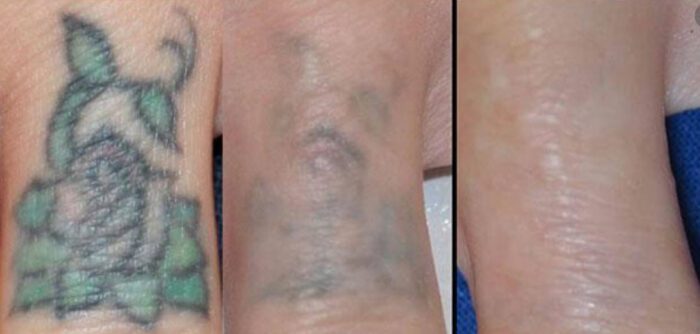Laser tattoo removal is becoming an increasingly popular way to get rid of unwanted tattoos. Using laser technology, tattoo removal clinics can break up the tattoo ink in your skin, allowing your body to naturally flush it out over time. However, like any medical procedure, laser tattoo removal has both advantages and disadvantages to consider before jumping in. In this article we talk about Laser Tattoo Removal Pros & Cons.
Pros
Effective at Removing Tattoos
Laser removal is considered the gold standard for tattoo removal techniques. The lasers target the tattoo ink specifically without damaging the surrounding skin. During each session, the laser breaks up the ink into tiny fragments that your immune system can eliminate over time. With multiple treatments, laser removal can eliminate a tattoo completely in the majority of cases, depending on the age, colors, and complexity of the tattoo.
Fewer Sessions Than Other Methods
Laser removal requires fewer sessions to fully remove a tattoo than other methods like surgical excision or dermabrasion. Most tattoos require between 3 to 10 sessions while older methods usually require at least 15 to 20 sessions to get full removal. The fewer number of sessions makes laser removal more convenient, with less downtime for healing between appointments.
Minimally Invasive
Laser tattoo removal is a minimally invasive, non-surgical procedure. The laser handpiece is simply held above the skin while the laser pulses break up the ink below. This is much less invasive than scrubbing off layers of skin or using a scalpel to cut the tattoo out surgically. There are no stitches required and minimal aftercare with laser removal.
Low Risk of Scarring
With laser removal, only the ink particles absorb the laser energy, leaving the surrounding skin intact. This means there is very little risk of scarring if performed correctly by an experienced technician. Conversely, aggressive methods like dermabrasion and excision surgery often result in permanent scarring on the treatment area.
Cons
Multiple Treatments Needed
Complete laser tattoo removal requires multiple sessions, usually spaced at least 8 weeks apart. Because it takes time for your body to naturally eliminate the shattered ink particles between sessions, one single treatment is never enough to fully remove a tattoo. Although laser removal requires fewer sessions than other methods, you still must commit to 6 months to 2 years of periodic treatments.
Doesn’t Work Well on Certain Tattoos
Laser removal is not equally effective on all tattoos. In particular, tattoos with vibrant colors like yellow, green, purple, aqua or fluorescent shades don’t respond as well. These pigments may turn black or leave behind a faint stain. Professional tattoos packed deeply into the skin also tend to be more stubborn to fully eliminate. Amateur tattoos with less dense ink application remove better.
Risk of Skin Reaction
Around 5-15% of patients can have minor to moderate skin reactions after laser removal sessions. Common side effects include redness, swelling, blistering, scabbing and temporary loss of pigmentation in the treatment area. These reactions typically resolve over 2-4 weeks but increase patient discomfort during the healing process between sessions.
Painful Treatment
Laser removal is usually more painful than getting your original tattoo. Because the laser penetrates the deeper skin layers to shatter ink particles, patients describe the sensation as a hot, rubber band snapping repeatedly on the tattoo site. For larger or colorful tattoos, especially over bony areas, anesthesia is sometimes used for enhanced comfort during the procedure.
Expensive Compared to Tattoo Cost
The cost of laser tattoo removal is usually several times higher than the original price paid for the unwanted tattoo. Multiplied over the several sessions necessary to see complete results, the total costs commonly range from $500 to $3000 depending on the tattoo size, location complexity, clinic pricing, and your geographical area. It’s an expensive way to remedy tattoo regret.
Conclusion
Laser tattoo removal offers a reliable way to eliminate unwanted tattoos through successive treatment sessions that break up ink particles for your body to naturally flush out. When performed correctly, laser removal is more effective, convenient, and less invasive than other older removal methods. However, there are some downsides to consider including the need for multiple treatments, mild pain and skin irritation during the healing phase, and higher overall costs for removal. Working with an experienced clinic can help maximize your results and safety. Weigh the pros and cons carefully as you determine if laser tattoo removal is the right choice for your unwanted tattoo. I sincerely hope you find this “Laser Tattoo Removal Pros & Cons” article helpful.

Raghav Sethi is a renowned tattoo artist at specialyoutattoo.com, where he shares his expertise on tattoo artistry and answers queries related to the craft. With over a decade of experience, Raghav combines artistic innovation with technical precision to create unique, personalized designs. His extensive portfolio highlights his versatility and dedication to the art form. For inspiration and to connect with Raghav, follow his Instagram.









